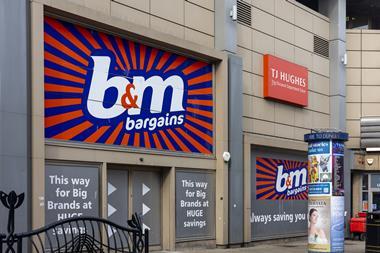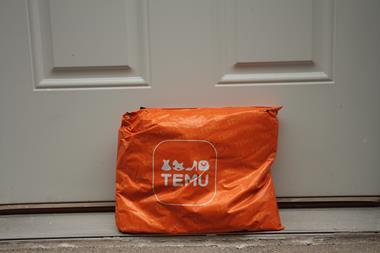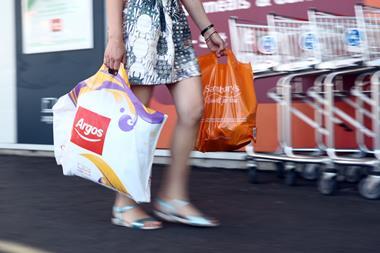Feeling miserable? Sick of reading about hard-up shoppers and soaring inflation? Well so are we, so here are three pages of nothing but good news and optimism. There is nothing anyone can do about the global economy, but plenty of opportunities still exist for those that are brave enough. Charlotte Hardie explains why now is the time to embrace the downturn.
1. It won’t last forever
Not unreasonably, many retailers are experiencing a certain level of panic at the moment – even if they would never admit it. But everything still needs to viewed in context. As Marks & Spencer executive chairman Sir Stuart Rose pointed out earlier this year, the difficulty for senior retailers is very few have traded through a downturn and thus don’t have the benefit of hindsight.
As Nick Greenspan, a London partner with Bain & Company and head of its UK retail practice, says, it’s not as if a decline hasn’t happened before and it’s not as if retailers haven’t bounced back. In the early 1990s, for example, “To let” signs were all over the high street (pictured). “If you go back to 1960, the UK has a slowdown every six to 12 years. The challenge is there hasn’t really been one since the early 1990s, so few senior managers have lived through this experience before.”
He adds that the textbook definition of a recession – two or more consecutive quarters of GDP decline – generally only lasts for about 10 months and the entire period of time when GDP growth is less than 2 per cent only lasts about two years. “So while it’s a painful time for retailers, looking back historically, it won’t last forever. That’s why leadership is so important. Yes, you have to take this seriously, but it’s about not panicking,” he says.
So, to use the words of Selfridges chief executive Paul Kelly, while events have affected financial institutions and markets, the world hasn’t stopped turning.
2. Advertising is cheaper
When times are tough, it’s understandably tempting to instantly rein in marketing spend. But, in actual fact, now is precisely the right time for your marketing drives to have an impact. If your competitors are cutting back in this area, you’re far more likely to get your brand’s voice heard.
Better still, you can get more for your money in the present climate. Paul Lyonette, UK sales manager at mobile ad agency Rhythm New Media, says that although the price has to be right for both parties, “deals are to be had across pretty much all media, as sales houses and media owners have targets to achieve”.
He adds: “When money isn’t prevalent in the market, there is more competition for the cash that is, as well as for the campaigns that are happening. This means the balance of power shifts to the spender.”
A group sales manager for one TV channel agrees. Broadcast ad spends are down for the year compared with 2007 and all the signs point to it dropping further in the autumn. “We’re having to fight for every penny. We can offer the big and small agencies alike incentives to put more money into us,” he says.
And don’t be tempted into thinking because the cost of advertising is going down it’s not effective. Veteran retail marketing expert Neil Kennedy says: “Advertising only exists because it works. Retailers are just about the meanest people in the world – they wouldn’t be responsible for 17 per cent of the UK ad cake if it didn’t.”
3. At last – some decent weather
OK, so nothing’s set in stone, but meteorologists don’t dream up long-range weather forecasts. It is a science in its own right; one that uses a number of meteorological and statistical techniques and, happily, there are glimmers of hope ahead.
Last year’s weather couldn’t have been worse for retailers – summer flooding followed by a balmy autumn and winter. This summer hasn’t exactly been a scorcher so far, but things may well improve. Positive Weather Solutions forecasts the UK will bask in fine weather for much of August, with temperatures “significantly above average”. Net Weather is also positive, forecasting a “drier month, with high pressure often centred close to the UK”.
And just when retailers want the temperatures to drop in early autumn to shift their autumn/winter stock, their prayers might be answered. Net Weather expects “a cooler outlook”, in contrast to last year’s mild autumn. For winter, The Weather Outlook says “there are some signals pointing towards colder conditions this year”.
If retailers pay attention to long-range forecasts, it could help their businesses significantly. Tim Morris, European managing director at business weather intelligence company Planalytics, says: “Understanding the weather’s impact on consumer behaviour and then making sensible plans that do not simply assume that next year will be the same as this can drive valuable margin points and allow for sensible, tactical cost-saving measures in inventory, markdown planning and intake phasing.”
4. Online is still soaring ahead
Britons spend an average of nearly 34 billion minutes on web sites and internet-related applications each month, according to Nielsen Online. So that’s 34 billion minutes that can be used to retailers’ advantage.
E-tailers are still proving they can buck the downturn that is being felt on the high street. At the end of June, Asos revealed sales for the full year to March 31 rocketed 90 per cent to£81 million and sales for the 13 weeks to the end of June leapt 95 per cent year on year.
Meanwhile at Mywardrobe.com, traffic to the site soared 138 per cent from June to July and sales increased 100 per cent.
Pixmania executive director Ulric J鲯me says: “It’s about buying power and online sales are continuing to soar because consumers have adopted this way of buying.” And, of course, online retail can offer much sought-after bargains. “In our categories, consumers can benefit from a 15 to 30 per cent price gap between internet and retail prices,” he adds.
J鲯me is also confident that the online retail market will remain resilient, even if the UK enters a recession. “The profile of online consumers is evolving – more women and silver surfers are joining – and because internet shoppers are satisfied with their experience, studies show that they usually repeat their buying while increasing their spend,” he says.
5. The retail workforce is improving
The sector may be struggling, but at least the calibre of people coming into retail businesses – both at head office and on the front line – is generally improving.
The launch of the Fashion Academy is just one vehicle that is improving young people’s perception of retail. Mosaic deputy chief executive Mike Shearwood says: “Retail still provides a vehicle for those who didn’t excel at school to have a successful career. It’s attracting more graduates with experience and, overall, the quality of people is getting better.”
Retail is also becoming more appealing to those within the higher echelons of academia. Fat Face chairman Alan Giles co-teaches a retailing course to MBA students at Oxford University’s Said Business School. He says the university was unsure of how MBA students would view a course on retailing when it was first run last year. In fact, about 30 per cent of the class – 67 students – selected it as an option. This year, nearly half of the MBA class chose it.
“Few of them had previously thought of retailing as a possible career choice, but I think the perception about the type of challenges and rewards that retailing can offer is changing,” explains Giles.
What’s more, even if they don’t end up in retailing careers and instead opt for companies such as private equity, investment banking or management consultancy, people now have a greater “realisation of the complexity of the challenges that retailers face and the calibre of people who work in the industry”, he says.
6. Favourable property terms
There has never been a better time in the past five years to acquire retail property space, which provides the perfect opportunity for retailers to drive growth. There is too much retail space available and about another 20 million sq ft is planned for the UK over the next three to five years. Even if a large proportion of that is shelved by developers, there will still be a huge amount that landlords are desperate to fill. In short, it is a buyers’ market.
Deloitte head of site location services Chris Garner says: “If you go back over the past five years, rent and wages have been rising above 6 per cent each year. Most retailers do not deliver like-for-like growth of more than 6 per cent each year, so they’ve been squeezed.” However, that is changing. “We’re all agreed it’s going to be choppy and now there is an opportunity to negotiate advantageous terms for longer,” he says.
Those terms could take the form of longer rent-free periods, lower service charges or turnover-based rents. “Some retailers use their property agencies effectively, others perhaps aren’t focused on the opportunities,” explains Garner.
If retailers think about how they can occupy space in a less costly way, “the opportunity exists for businesses to have an array of profitable stores that outperform the group average”, he adds.
7. We’re not all strapped for cash
It’s easy to forget that not everyone is feeling the pinch. There are still millions of lucky people who are merrily spending without a care in the world.
One group is teenagers and early 20-somethings – many of whom have barely any outgoings and pockets lined with cash from part-time jobs. In April this year, Arcadia owner Sir Philip Green told Retail Week that Topshop and Topman will have their best years to date in 2008. And, two weeks ago, reports that sales at the group’s youth brands – Topshop, Topman and Miss Selfridge – had rocketed past the£1 billion mark is evidence there are still bright spots in retail with potential for growth. He said: “The younger generation is obviously not quite ready to curb their lifestyles; we are seeing double-figure like-for-likes on Topman and significant gains on Topshop and Miss Selfridge.”
In a different league altogether is the super wealthy, for whom food and fuel increases, inflation and interest rates are virtually irrelevant. Retailers catering for this elite are more insulated than their high street counterparts. Burberry’s results for the three months to June 30 reflect this – retail sales leapt 14 per cent and total revenue for the first quarter jumped 22 per cent, with comparable store sales growth of 4.5 per cent. So not everyone is battening down the hatches. Far from it, in fact.
8. EBay’s under pressure
EBay has been a thorn in many retailers’ sides for years. Aside from being one of the UK’s most popular e-tailers, it is a destination for selling stolen and counterfeit goods. What’s more, retailers have been largely powerless to do anything about it. An Argos spokeswoman told Retail Week last year: “There is no simple way to contact eBay if we suspect a stolen item is being sold, as they will only accept an approach via a law enforcement agency.”
Two high-profile legal cases in recent weeks have had very different outcomes for eBay, but both have their upsides for retailers. One involved luxury powerhouse LVMH. EBay was fined 40 million (31.7 million) by a French court after it ruled that eBay’s French site had not taken adequate steps to stop the sale of counterfeit LVMH goods. The second involved Tiffany in the US, where a judge ruled that eBay could not be held responsible for policing site contents.
Even the latter case spells good news for retailers. Kate Withers, an Eversheds associate specialising in intellectual property, says: “EBay has stepped up and responded. It does seem to be taking action upon being notified of the sale of counterfeit goods and there is now a mechanism in place for brand owners.”
Perhaps even more significant is the effect that such ongoing negative media publicity about eBay has on public perception. “You can never be 100 per cent certain that what is being sold is genuine. It’s extremely difficult to verify,” says Withers.
Retailers take heart. EBay is not the unstoppable force it was once perceived to be.
9. The new Mayor of London
He may be seen as a bumbling buffoon with a reputation for entertaining antics but, actually, the new Mayor of London may well spell good news for retailers in the capital.
His Daily Telegraph column revealed last week that he is far more pro-supermarket (and even – horror of horrors – pro Tesco) than many other politicians would dare to admit. “The brute fact is that Tesco provides food of fantastic quality at reasonable prices, it stays open late, the staff are friendly,” he wrote.
More specifically, some of Johnson’s decisions may boost trade for London retailers. Those in the congestion charging zone have long complained that the£8 tax on drivers is deterring people from shopping. Former mayor Ken Livingstone extended the zone to cover parts of Kensington, Chelsea and Westminster, but Johnson has launched a five-week consultation into the move. In September, residents, businesses and stakeholders will help decide whether it should be continued, altered or abolished.
And, earlier this month, Johnson scrapped plans to make owners of the most gas-guzzling vehicles pay a£25 daily congestion charge. The obvious consumer group to benefit is families with their Chelsea Tractors, but it could also cheer up the super wealthy.
As Harvey Nichols group chief executive Joseph Wan told Retail Week earlier this year, such levies affect the feel-good factor – and thus shopping enthusiasm – of even the richest. “If you live in Belgravia and you’re told that driving around in your Bentley will cost you£25 a day, how would that make you feel? It’s the principle, not the money,” he said.
10. Some markets are still growing
We’re constantly hearing about how the US and local economies are spiralling downwards, but let’s not forget about the international picture. “We tend to look at it from a Western perspective when, in actual fact, the developing economies are still having a very nice time, thanks very much,” says PricewaterhouseCoopers UK retail and consumer sector leader Mark Hudson.
Some of the many countries that offer particularly strong growth include Russia, India and China. The urban middle classes in these markets are a particular target because of their desire to buy into Western tastes. The retail market in China, according to estimates by research and consulting company PMR, will grow 20 per cent and exceed 970 billion (769.85 billion) this year. Euromonitor International forecast that the Indian retail market will grown 39.6 per cent in value terms between 2006 and 2011.
Furthermore, retailers shouldn’t forget the opportunities afforded by selling online to customers in Europe, adds Hudson. The present exchange rate favours UK prices if you’re based on the Continent, so setting up an international version of your web site could be the perfect way to increase online sales. Providing that fulfilment is done in the UK, it’s also a good, low-cost way to establish your brand in another country and test the market with a view to establishing physical stores.
So if there is scope to make more of an impact overseas, now is the time to do it.


























No comments yet